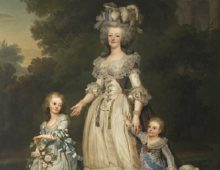Tagged with War and Warfare
Resource : Nelson’s Coat
This coat was worn by Admiral Lord Horatio Nelson when he commanded the British fleet at the Battle of Trafalgar, in 1805. In this major sea battle, the British navy defeated the combined fleets of the French and Spanish navies, temporarily ending Napoleon Bonaparte’s threat to invade Britain. Although this coat made Nelson highly conspicuous during the battle, he chose to wear it on deck to inspire his men. Nelson was shot at the height of the battle and mortally wounded. The bullet hole can be seen on the left shoulder of the coat.
Resource : La Marseillaise
Soldiers have always sung to keep their spirits up, and wars always produce songs. The Marseillaise is one of the most memorable war songs ever written. It tells us about the hopes and fears of French soldiers in 1792, during the French Revolution. In 1795 it became France’s national anthem and is now known today all over the world.
Resource : Tom Paine’s writing desk
Thomas Paine was a radical political philosopher and advocate of human rights. He was one of the most influential writers and activists of his time who heavily influenced the American and French revolutions.
Resource : Benjamin Franklin after Joseph Siffred Duplessis, based on a work of 1783
Benjamin Franklin (1706–1790) was an American printer, inventor and scientist, who developed an international profile and went on to become a Founding Father of the United States of America, along with men like George Washington, Thomas Jefferson and Alexander Hamilton. He played a key part in the drafting of the Declaration of Independence, the defeat of Britain in the war, and the creation of the American Constitution.
Resource : The Haitian revolution (1791-1804)
The first – and only – successful uprising of enslaved Africans, establishing Haiti as the first independent ‘black’ republic.
Resource : French revolutionary and Napoleonic wars (1792-1815)
A series of wars which reconfigured nations and societies within Europe, across the Atlantic, and far beyond, culminating in the legendary Battle of Waterloo.
Resource : American revolution
How the American colonies defied Britain, one of the mightiest powers on earth, to secure their independence and form a new federal republic – the United States of America.
Resource : War and the international order
The wars precipitated by the struggles for independence and attempts at empire building that characterise the Age of Revolution, and their impact on the changing world map.
Resource : Bust of Jean-Jaques Dessalines (1758 – 1806)
Jean-Jacques Dessalines (1758 – 1806) was born into slavery in St Domingue (now Haiti) on the Caribbean island of Hispaniola. Following a mass uprising of enslaved people of African origin – the only successful slave revolt in history – and a series of bloody battles and reprisals, Dessalines eventually became the first ruler of Haiti, the world’s first modern independent ‘black’ republic. The events in St Domingue became known as the Haitian Revolution.
Resource : Toussaint Louverture, Chief of the French Rebels in St Domingo
Toussaint Louverture (1743 – 1803) was born into slavery in St Domingue (now Haïti) on the Caribbean island of Hispaniola. In 1791 he led the first – and only – successful uprising of enslaved Africans. Although he died before the revolution spawned a nation, in 1804 Haiti became the first independent ‘black’ republic and contributed to the decline of the transatlantic slave trade. The events in St Domingue became known as the Haitian Revolution. This and other depictions of Louverture (in print and portraiture) reflected the high levels of fascination and respect expressed around the world for a radical figure who had refused to yield and who surmounted all foes in the revolutionary contests.


